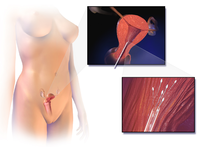
Photo from wikipedia
Abstract Worldwide, cervical artificial insemination using frozen–thawed semen yields low pregnancy rates. The only exception to this is in Norway, where vaginal insemination with frozen–thawed semen yields pregnancy rates in… Click to show full abstract
Abstract Worldwide, cervical artificial insemination using frozen–thawed semen yields low pregnancy rates. The only exception to this is in Norway, where vaginal insemination with frozen–thawed semen yields pregnancy rates in excess of 60% and which has been attributed to the specific ewe breed used. Our previous work demonstrated differences in cervical gene expression at the follicular phase of the estrous cycle in ewe breeds with known differences in pregnancy rates. In this study, we characterized the cervical transcriptome of the same ewe breeds [Suffolk, Belclare, Fur, and Norwegian White Sheep (NWS)] during the luteal phase, as an optimal environment at the luteal phase could better prepare the cervix for sperm migration through the cervix at the subsequent follicular phase. High-quality RNA extracted from postmortem cervical tissue was analyzed by RNA sequencing. After stringent filtering, 1051, 1924, and 611 differentially expressed genes (DEGs) were detected in the low-fertility Suffolk breed compared with Belclare, Fur, and NWS, respectively. Gene ontology analysis identified increased humoral adaptive immune response pathways in Suffolk. Increased expression of multiple immune genes supports the presence of an active immune response in the cervix of Suffolk ewes, which differentiates them significantly from the other three ewe breeds. Inflammatory pathways were upregulated in the Suffolk, resulting in higher expression of the potent pro-inflammatory cytokines. Therefore, higher levels of pro-inflammatory cytokines indicate unresolved inflammation in the cervix of the low-fertility Suffolk breed that could contribute to reduced cervical sperm transport in the next follicular phase. Summary Sentence Increased humoral adaptive immune response in the low-fertility Suffolk breed at the luteal phase indicates unresolved inflammation in the cervix of Suffolk that may contribute to reduced cervical sperm transport in the subsequent follicular phase. Graphical Abstract
Journal Title: Biology of Reproduction
Year Published: 2022
Link to full text (if available)
Share on Social Media: Sign Up to like & get
recommendations!